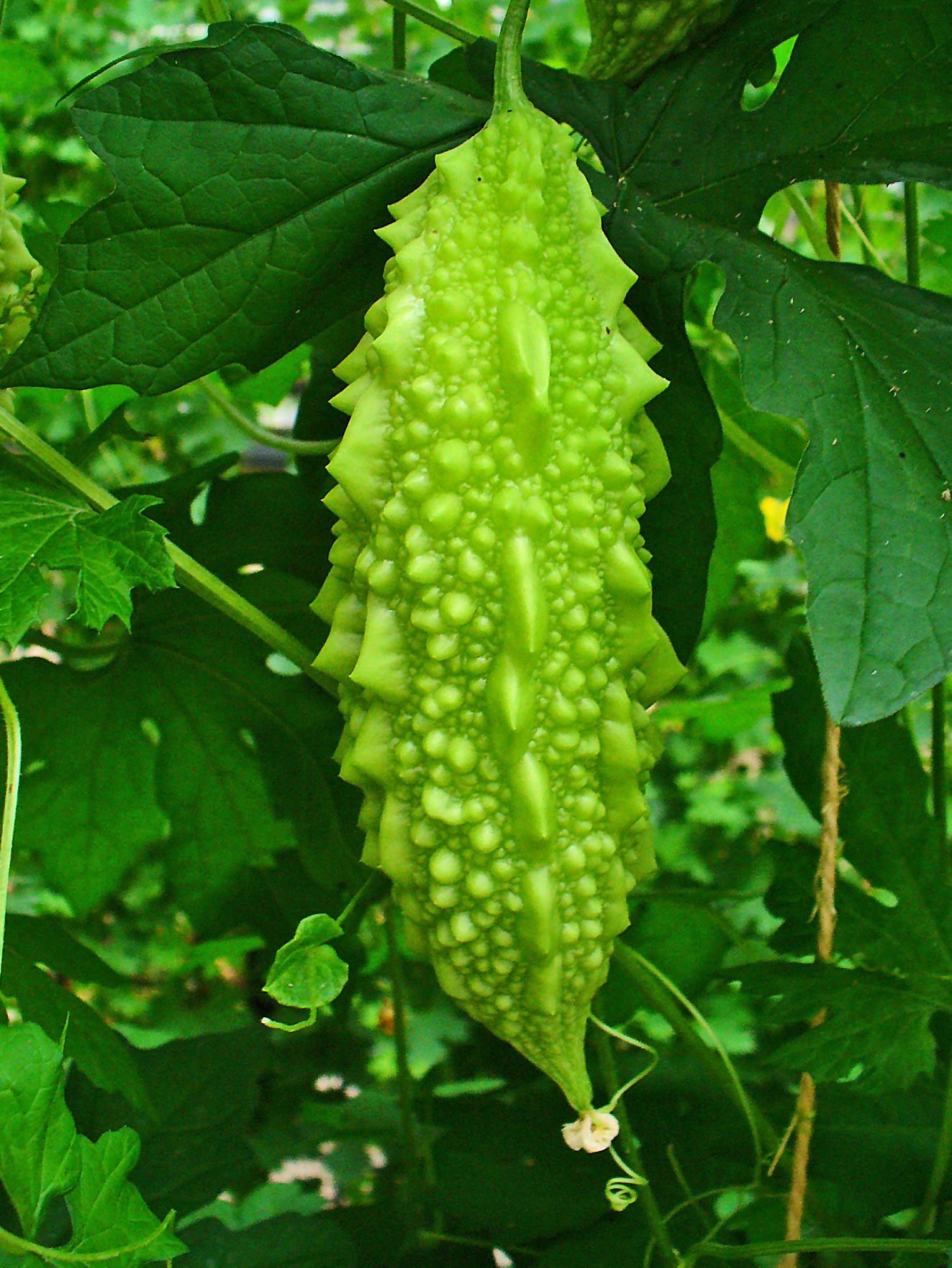Momordica charantia L.
| Botanical Name | Momordica charantia L. |
| Order: | Cucurbitales |
| Family: | Cucurbitaceae |
| Genus: | Momordica |
| Species: | M. charantia |
| Common Names: | Balsam pear, African cucumber, Cundeamor, Bitter apple, Bitter melon, Cariila plant, Wild cucumber, Bitter cucumber (English); Poire de balsame, Concombre Africain, Margose, liane/pomme de merveilles (French). |
Plant Synonyms
Momordlca thollonli Cogn.
Plant Local Names
Benin: Fon / Goun — Nyesinken, Yorouba —Edjini, Dendi — Atakluma
Burkina Faso: Fulfildé — Njalam fetuhi
cote d'lvoire: Adioukrou — Sing Biep, Guéré-N'guéné Boue
Ghana: Akan — Nyanya, Ewe — Kakle, Hausa —Daddagu
Nigeria: Yoruba — Ejlnrin
Togo: Ewe — Agnagnran, Adja — Adounka, Mina— Guéssikan
Plant Habitat
Pantropical species, widely grown in Asia, Africa, and the Caribbean for its edible fruit; native to India, but widespread throughout the tropics; occurring mainly in areas with more or less humid climate; occurs as a weed along roadsides and outskirts of towns,, among hedges, bushes or shrubs and abandoned crops; sometimes cultivated in homes.
Plant Material of Interest
Leaf , fruit, Whole plant, root
Plant Description
Climbing herbaceous, tendril-bearing vine, grows to 5 metres; leaf digital and lobed, alternate, petiolate, long-stalked and provided with co-petlolar tendrils fine and simple blade, generally pentagonal, divided into five main lobes, 2 to 6 cm long, 10 to 25 mm wide, a rounded top; 2-5 secondary veins per lobe; leaf-base deeply cordate and 3-veined; hair soft and smooth on both sides, thin top, longer and denser on the veins beneath; golden yellow flowers 3 cm wide, 5 lobes obtuse at the top corner, with three longitudinal ridges, male flowers on top of an axillary peduncle, 4 to 7 cm long, leafy bracts cordate siightly above the base, female flowers at the top of the ovary, peduncle 3 to 4 cm and covered with dense spines; fruit berry, distinct warty exterior and oblong shape, hollow in cross-section, with a thin layer of flesh surrounding a central seed cavity filled with large flat seeds and pith; seeds and pith appear white in unripe fruits; bright orange at maturity, 3 to 6 cm long, 2-3 cm wide, soft spines; as the fruit ripens, the flesh becomes tougher, more bitter and too distasteful.
Plant Used Parts
Plant Uses
M. charantia is a popular medicinal plant widely used in traditional medicine in all humid and sub-humid tropical countries, where they grow spontaneously. Among the Yorubas of Nigeria, the decoction is used to treat malaria and in Senegal, the leaves are indicated for fever, whilst the fruits and leaves are used against itchy skin conditions such as scabies (Paulino de Albuquerque at al., 2007). The decoction or poultice of the leaves is used to treat mouth sores, gangrenous wounds and gastric ulcers (Agyare et al., 2009), while the whole plant is used to treat malaria, stomach ache, stomach acidity, fever, diarrhoea, intestinal parasites and kidney complaints (Luziatetli et al., 2010). Fruit, tender shoots and tender roots are used for diabetes, blood purification and snake bite. Others also use the leaves to treat rabies, chest and rheumatic pains
Plant Therapeutic Action
Antimicrobial; antidiabetic; antidiarrhoeal; antifertility; antihelminthic; antiinflammatory; antineoplastic; antioxidant, antitumor, antiulcer; antiviral; astringent; febrifuge; vulnerary.
Plant Precaution for Use
Control of the blood sugar required in case of administration of aqueous leaf and bark extracts.
Avoid co-administration with other antidiabetic medicines except under medical supervision.
Plant Adverse Effect
Antifertility effects and abortion were observed in female animals, decrease in male fertility rate but there was no effect on sperm production, hypoglycaemic coma and convulsions
Plant Contraindication
Persons with a genetic erythrocytic deficiency of glucose 6-phosphate dehydrogenase; pregnancy
Plant Dosage Forms
Decoction; infusion; tincture; tablets; capsules
Plant Dosage
Decoction: 30 g dried aerial parts in 900 ml water; simmer until reduced to 600 ml; 1 teacup three times daily
Infusion: 30 g dried aerial parts in 600 ml of water; 1 teacup three times daily
Tincture: 1:5 in 45% alcohol; 5 ml three times daily
Capsules: 1 -2 g of powdered leaf, 1 capsule two times daily
Plant Storage
Store in a cool dry place
Plant Chromatographic Fingerprint
Plant Constituents
Charantin, vicine, polypeptide-pf momordicine 1, 2 and 3, momorcrines A and B, momordine, arginine, asparagine, aspartic acid, leucine, leusine, tyrosine, fixed oil; acid resins; vitamin C; carotene; Y-aminobutyric acid; mineral salts (e.g. salts of silicon, calcium, phosphorus, strontium, copper, lead, zinc, sodium and iron); pectic acid, pectin; saponins, 5-hydroxytryptamine; albumin, globulin and glutelin rich in essential amino acids and vitamin B, carotene and alpha-amino butyric acids; alkaloids, saponins (Olaniyi and Marquis, 1975)
Plant References
Agyare, C., Asase, A., Lechtenberg, M., Niehues, M. et al. (2009). An ethnopharmacological survey and in vitro confirmation of ethnopharmacological use of medicinal plants used for wound healing in Bosomtwi-Atwima-Kwanwoma area, Ghana. Journal of Ethnopharmacology 125:393^03.
Alam, S., Asad, M„ Asdaq, S.M.B., Prasad, V.S. (2009). Antiulcer activity of methanolic extract of Momordica charantia L. in rats. Journal of Ethnopharmacology 123:464-469.
Beloin, N., Gbeassor, M., Akpagana, K., Hudson, J. et a!. (2005). Ethnomedicinal uses of Momordica charantia (Cucurbitaceae) in Togo and relation to its phytochemistry and biological activity. Journal of Ethnopharmacology 96:49-55.
Best, C.H., Smith, R.G., Scott, D.A. (1924). An insulin-like material in various tissues of the normal and diabetic animal. American Journal of Physiology 68:161-182.
Dennis, F. (Ed) (2002). Manual for the propagation of medicinal plants in Ghana. Darwin Initiative for the Survival of Species.
Derrida, M. What is Bitter Melon (Momordica charantia): What is Bitter Melon used for today? htpp://www.mdidea.com/products/herbextract/bitt ermelon/data.html

